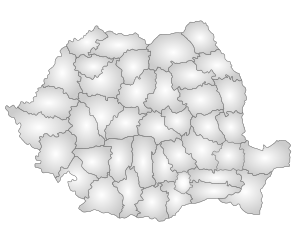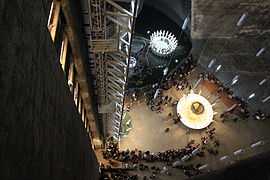Cluj County
| Cluj County Județul Cluj | ||
|---|---|---|
| County | ||
|
Păniceni wooden church | ||
| ||
 Cluj county, territorial location | ||
| Country |
| |
| Development region | Nord-Vest | |
| Historical region | Transylvania | |
| County seat | Cluj-Napoca | |
| Government | ||
| • Type | County Council | |
| • President of the County Council | Mihai Seplecan (National Liberal Party) | |
| • Prefect2 | Gheorghe Vușcan | |
| Area | ||
| • County | 6,674 km2 (2,577 sq mi) | |
| Area rank | 12th in Romania | |
| Elevation | 1,842–227 m (6,043–745 ft) | |
| Population (2011 census[1]) | ||
| • County | 691,106 | |
| • Rank | 4th in Romania | |
| • Density | 102/km2 (260/sq mi) | |
| • Urban | 434,201 (66%) | |
| Time zone | EET (UTC+2) | |
| • Summer (DST) | EEST (UTC+3) | |
| Postal Code | 40wxyz3 | |
| Area code(s) | +40 x644 | |
| Car Plates | CJ5 | |
| GDP | US$ 7.65 billion (2008) | |
| GDP/capita | US$ 11,177 (2008) | |
| Website |
County Board County Prefecture | |
|
2 as of 2007, the Prefect is not a politician, but a public functionary. He (or she) is not allowed to be a member of a political party, and is banned to have any political activity in the first six months after the resignation (or exclusion) from the public functionary corps 3w, x, y, and z are digits that indicate the city, the street, part of the street, or even the building of the address 4x is a digit indicating the operator: 2 for the former national operator, Romtelecom, and 3 for the other ground telephone networks 5used on both the plates of the vehicles that operate only in the county limits (like utility vehicles, ATVs, etc.), and the ones used outside the county | ||
Cluj (Romanian pronunciation: [kluʒ]); is a county (județ) of Romania, in Transylvania, with the capital city at Cluj-Napoca.
Name
In Hungarian, it is known as Kolozs megye, and in German as Kreis Klausenburg. During Austro-Hungarian administration, before 1918, there was a county with similar name (see: Kolozs County).
Demographics
In October 2011, it had a population of 691,106 and a population density of 102/km².[1]
- Romanians – 80.09%
- Hungarians – 15.93%
- Roma – 3.46%
| Year | County population[2][1] |
|---|---|
| 1948 | 520,073 |
| 1956 | |
| 1966 | |
| 1977 | |
| 1992 | |
| 2002 | |
| 2011 |
Geography
This county has a total area of 6,674 km². About 1/3 of this surface are mountains—the Apuseni Mountains, with heights up to 1800 m and located in the Southwest part of the county. The rest of the surface is the North side of the Transylvanian Plateau, a hilly region with deep and wide valleys.
The main rivers in the county are Someșul Mic, Arieș, and Crișul Repede.
Neighbours
- Bihor County to the West.
- Mureș County and Bistrița-Năsăud County to the East.
- Sălaj County and Maramureș County to the North.
- Alba County to the South.
Economy
Cluj County has one of the most dynamic economies in Romania. It is a region with one of the highest ratings of foreign investments. In addition, Cluj-Napoca is home to one of Romania's important IT and financial services centers.
The county's main industries are:
- Mechanical components;
- Wood processing;
- Glass manufacturing;
- Pharmaceutics and cosmetics;
- Food stuffs processing;
- Textiles.
Mining and natural gas extraction are also developed.
Tourism
The main tourist destinations in the county are:
- The city of Cluj-Napoca.
- The Apuseni Mountains especially the caves Peștera Mare, Peștera Piatra Ponorului, Peștera Vârfurosu.
- The historical centers of Turda, Dej, Gherla, Ciucea.
- Cheile Turzii
- Turda Salt Mine
- The winter resort of Băișoara
- The lakes of Beliș and Tarnița
Education
Administrative divisions
Cluj County has 5 municipalities, 1 town and 75 communes.
- Municipalities
- Câmpia Turzii
- Cluj-Napoca – capital city; 324,576 (as of 2011)
- Dej
- Gherla
- Turda
- Towns
- Communes
- Aghireșu
- Aiton
- Aluniș
- Apahida
- Așchileu
- Baciu
- Băişoara
- Beliș
- Bobâlna
- Bonțida
- Borșa
- Buza
- Căianu
- Călărași
- Călățele
- Cămărașu
- Căpușu Mare
- Cășeiu
- Cătina
- Câțcău
- Ceanu Mare
- Chinteni
- Chiuiești
- Ciucea
- Ciurila
- Cojocna
- Cornești
- Cuzdrioara
- Dăbâca
- Feleacu
- Fizeșu Gherlii
- Florești
- Frata
- Gârbău
- Geaca
- Gilău
- Iara
- Iclod
- Izvoru Crișului
- Jichișu de Jos
- Jucu
- Luna
- Măguri-Răcătău
- Mănăstireni
- Mărgău
- Mărișel
- Mica
- Mihai Viteazu
- Mintiu Gherlii
- Mociu
- Moldovenești
- Negreni
- Pălatca
- Panticeu
- Petreștii de Jos
- Ploscoș
- Poieni
- Râșca
- Recea-Cristur
- Săcuieu
- Săndulești
- Săvădisla
- Sâncraiu
- Sânmartin
- Sânpaul
- Sic
- Suatu
- Tritenii de Jos
- Tureni
- Țaga
- Unguraș
- Vad
- Valea Ierii
- Viișoara
- Vultureni
References
| Wikimedia Commons has media related to Cluj County. |
- ↑ 1.0 1.1 1.2 "Population at 20 October 2011" (in Romanian). INSSE. 5 July 2013. Retrieved 9 July 2013.
- ↑ National Institute of Statistics, "Populația la recensămintele din anii 1948, 1956, 1966, 1977, 1992 și 2002"
External links
- (Romanian) Cluj County Council
- (Romanian) Cluj County Prefecture
- (Romanian) Cluj County map
| ||||||||||||||||



